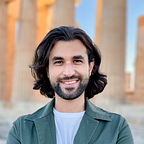The Q-shaped designer
I’ve always thought that design is about connecting the dots. Combining pieces of information and memories to form one solid result. These fragments of knowledge could be very random, you may combine a memory from your childhood with a color from a painting and a small article about psychology, to give you a new idea about your current project.
All it takes is for you as a designer to always be on the look for these little fragments of information that live inside your brain, and then use them to solve a problem or create something new.
It’s like those drawings that we made back when we were kids. The ones with numbered dots and all you had to do was to connect them one by one. At first, you couldn’t even tell what the end result would be, it seemed so random, but then slowly you got the picture.
As a designer, you have to train your mind and eyes to always be curious and notice things around you.
It’s really like training a muscle, everyone can do it, you just have to put in the time. Once you do that, you can zoom in and out to see the big picture or focus on details.
You cannot work in a silo. 👩💻
I ones heard that one should know everything about one thing and one thing about everything. You have to be able to know at least something about everything. That’s what makes design so beautiful. It feels weird to me when people say that I am a graphic designer, or I am a UI designer. For me, this is just a title, it’s not who you are.
A designer should be all over the place, moving from one thing to another, having a spherical knowledge about the world and society. Multidisciplinary, interdisciplinary, call it as you like. Of course, you need to focus on one thing at the time, but focusing doesn’t mean you have to shut your eyes and ears to anything else that stimulates your curiosity.
I believe that nowadays, a designer who doesn’t know anything about how businesses work, about marketing and about coding is doomed to always come last. No matter how good a designer you are, you will always get hired to create “beautiful things.”
I, T and Q-shaped people. 🤯
Generally, people are either I-shaped or the T-shaped. To quickly explain these two, the I-shaped professional is a person who is very focused on one discipline, he is a master at his game, the T-shaped professionals are characterized by their deep disciplinary knowledge in at least one area, but they also have knowledge and skills for multiple disciples.
The problem with the I-shaped people is that in our contemporary company team structures, we need people to collaborate and work together towards one goal. Companies no longer work like assembly lines, if people in their group meetings can’t build on each other’s ideas, then there is no progress, no real connection between people with different knowledge backgrounds.
So the T-shaped people come to the rescue. As Tim Brown, the CEO of IDEO states in this interview, these people are composed of two things:
“First, empathy. It’s important because it allows people to imagine the problem from another perspective- to stand in somebody else’s shoes. Second, they tend to get very enthusiastic about other people’s disciplines, to the point that they may actually start to practice them. T-shaped people have both depth and breadth in their skills.”
The Q-shaped designer. 🧠💪
Coming back to the designers now, I came up with a different letter, the Q. The Q-shaped designer.
Why Q and not T? Well, first of all, I believe that this is specific for designers. There is nothing wrong with the T-shaped model, it is just that when it comes to design, things are a little different. The concept is kind of the same, but the skills are not linear, they are connected, at least they have to be.
I picture the design skills as a circular concept. You can begin from any point you like, but your goal is to go around the circle and try to meet the starting point. Sounds complicated? 🤔
Check the diagram below.
What it means.
The colored circle represents the design spectrum, and the white stroke following it is your disciplines, the stuff that you already know. The vertical line to this arc is the area that you are currently focusing on. 🤓
For example, this is me, the colored circle represents the design spectrum, and the white stroke, my disciplines. I started by forming my knowledge with traditional art drawing classes and painting, moved to graphic design in my college years, then branding and marketing in my work. Now I explore the user experience and cognitive science field.
At every single point of this journey, you are focusing on something different, you can move clockwise into this or anticlockwise or even work on this more arbitrarily, although I think that’s tougher.
Conclusion. 📝
So to sum up, people nowadays tend to put tags on themselves, draw boundaries and limit their thoughts to them. But as a designer in the 21 century, you cannot do that. You have to be as versatile and multidisciplinary as possible to succeed, stand out, and create great things in your career.
For me, this is not an entirely different concept from the T-shaped one, but as a designer, I tend to see things a bit differently, and in a more visual kind of way, so this visual concept makes more sense to my eyes. It’s a concept that I would like to explore more and get some feedback, so please feel free to contact me and share your ideas about it.
